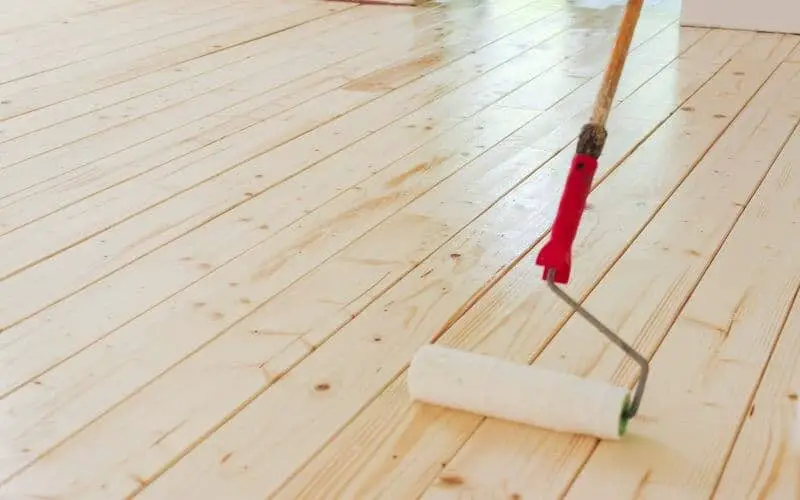Hardwood floors need to be sealed at all times. This is to protect the wood from impacts by humidity, spills, and general foot traffic.
Before now, wax, penetrating oil, and shellac was used as sealers on hardwood floors. But currently, polyurethane varnish has become the default sealers for hardwood floors.
Let’s look into how to seal hardwood floors without sanding. There are two basic methods: buffing or abrading before sealing or using a chemical etching kit.
If you’re familiar with the process involved in sealing hardwood floors, you will know that you will need to sand it before sealing your hardwood floor.
Read on as we walk you through these processes.
Read: How to seal pebble shower floor
How to Seal Hardwood Floors Without Sanding
As mentioned earlier, it may seem that sanding before sealing hardwood floors is a prerequisite. But luckily enough, that’s not always the case. Below are two methods to easily skip the whole sanding process before sealing:
1. Method 1: Buffing and Recoating
In this method, you will have to scuff the hardwood coat before sealing. Below are the steps involved in changing the color of hardwood floors without sanding.
- First thing first, notes that if the floor has a wax finish, it cannot be buffed or abraded because it will end up leaving ugly bubbles. Buffing only works on floors with lacquer or oil-based sealers. To determine the type of finish used on the hardwood floor, apply mineral spirits or thinner in an inconspicuous area and wipe immediately with a clean rag. If the rag turns yellow or brown, the finish is wax and thus can’t be buffed.
- Once you have determined that the floor doesn’t have a wax-based finish, proceed to clear the room of all furniture and sweep the room with a broom.
- Make minor repairs on the floor (if necessary), such as pounding protruding floorboard nails with a hammer and filling holes with some wood putty.
- After making the repairs, you will need to clean the floor thoroughly with a broom or vacuum, then mop the floor with a commercial wood floor cleaner to remove contaminants.
- You can now start to abrade your floor by rubbing your hands lightly over it or use a buffing machine.
- At this stage, do not sweep the floor to remove the dust but rather vacuum. Using a broom will move the dust to get trapped in the cracks, while a vacuum cleaner will suck up the dust thoroughly.
- After vacuuming, you can get to real work, which is sealing. You can use lacquer or oil-based sealer/finish.
Read: How to buff tile floors
Method 2: Chemical Etching Kit
Suppose you think that the buffing and recoating method is a bit too complicated. In that case, you can easily opt for the next method of sealing without sanding: using a chemical etching kit. Follow these steps for this method:
- First, you will have to determine if this method is the best way to restore your floor. The chemical etching kit method is only suitable for hardwood floors that are slightly worn and scratched not woods that are completely damaged.
- Just like the buffing and recoating method, The chemical etching kit method is not suitable for floors with a wax finish. Use a thinner to determine if the floor has a wax finish, as explained above.
- A refinishing kit can be purchased at a large hardware store or home center. You will also need to buy a paint tray, bucket, sponge mop, paintbrush, a shop vacuum, shoe covers, painter’s tape, and abrasive pads if you don’t have them.
- Just like the buffing and recoating method, you will need to sweep the floor thoroughly before getting to work.
- Use the liquid etcher to roughen the floor surface. Follow the manufacturer’s instructions on the label of the liquid etcher carefully. Use the abrasive pad that comes with the liquid etcher kit to scrub the floor firmly.
- Mop the floor with two tablespoons of a liquid dishwasher with one gallon of warm water to neutralize the etcher and remove the remaining residue.
- If your floor has some scratches, smooth them by applying a matching stain with an artist’s brush.
- Now, you can go on to apply your lacquer or oil-based sealer/finish. And when you are done, allow the finish to dry for at least a couple of weeks before putting down a rug.
Read: How to remove paint from hardwood floor
Conclusion
Many homeowners are not fans of sanding their hardwood floor to restore it. This is because sanding is labor-intensive and time-consuming, and it’s not even suitable for thin floors.
This article on how to seal hardwood floors without sanding provides equally effective ways to seal your floors without sanding. We hope the methods discussed here will prove helpful.

